Top Thermal Camera Drones for Aerial Imaging in 2025
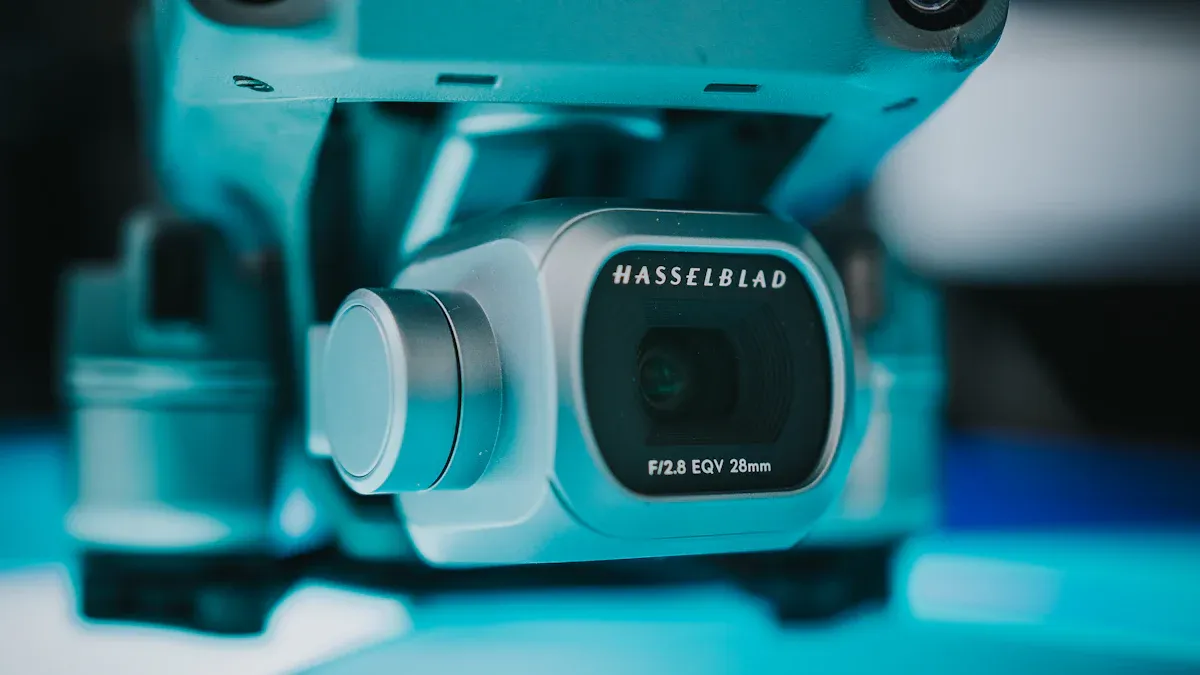
When you look for the best thermal drones in 2025, you will see top choices like the DJI Mavic 3T and Autel EVO Max 4T. These drones stand out because the thermal camera used in drone technology is advancing rapidly. Consider these numbers:
Aspect | Numerical Evidence | Impact in 2025 |
|---|---|---|
Flight Time Improvement | Longer missions, less downtime | |
Thermal Camera Resolution | Higher-resolution sensors | Clearer images, even in smoke or darkness |
Approved Drone Models | 16 from 9 U.S. makers (2024) | More choices for secure, sensitive work |
Cost Impact | 30-50% higher for Blue UAS | Trade-offs in compliance and features |
Thermal drones now provide clearer images, longer flights, and more options than ever before. The thermal camera used in drone systems today delivers detailed and reliable results. Whether you’re a professional or a drone enthusiast, choosing the right features to fit your needs is essential. With the growing market for thermal imaging, you’ll find better tools for inspections, search and rescue, or creative projects.
Key Takeaways
Thermal camera drones in 2025 give clearer pictures. They can fly longer and have new features. These help with firefighting, search and rescue, and inspections. They are also useful for other jobs.
Top drones like DJI Mavic 3T and Autel EVO Max 4T have high-quality thermal sensors. They have strong zoom and can avoid obstacles. This makes aerial imaging safe and detailed.
Picking the best drone depends on what you need and how much you can spend. It also depends on your job. Professionals need better sensors and software. Hobbyists can choose simple and cheaper drones.
You must follow the law and get the right training. Take care of your drone often. This keeps flying safe and helps your drone last longer.
Thermal imaging drones help save time and money. They find heat fast and safely. They work even in the dark, smoke, or bad weather.
Best Thermal Drones 2025
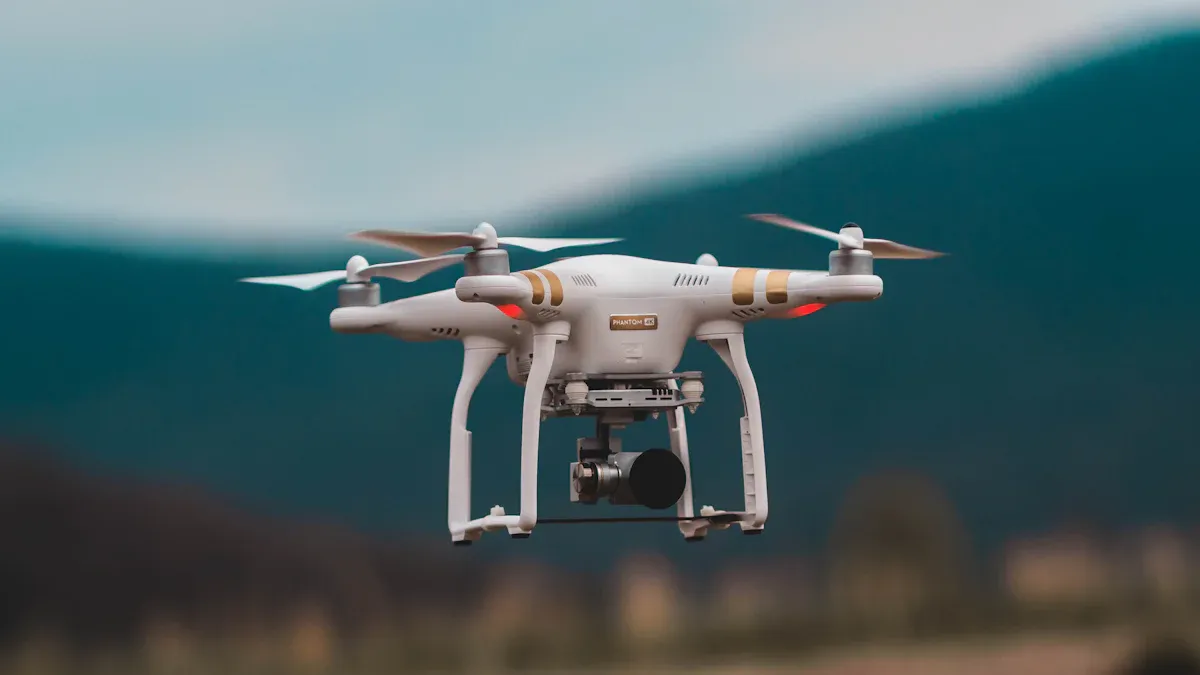
Are you searching for the best thermal drones in 2025? There are more options now than before. Let’s look at some top models and see why they are good for aerial imaging, inspections, and night vision drones jobs.
DJI Mavic 3T
The DJI Mavic 3T is small but powerful. It has a 640×512 thermal camera and a 48MP wide camera. The 50x hybrid zoom helps you see small things from far away. This drone can fly for up to 45 minutes. You can check large areas in one flight. It also has sensors to avoid obstacles, so you can fly safely.
The Mavic 3T is great if you need a small drone for emergencies, search and rescue, or building checks. Its thermal camera gives clear pictures, even in smoke or darkness. Many people choose this drone because it is strong and easy to carry.
Tip: The Mavic 3T shows thermal overlays in real time. This makes it popular for night vision drones in firefighting and rescue work.
Autel EVO Max 4T
The Autel EVO Max 4T has a 640×512 thermal camera, a 50MP wide camera, and a 10x optical zoom. It can fly for up to 42 minutes, so you do not need to change batteries often. The 720° obstacle avoidance keeps the drone safe from all sides.
This drone is good for search and rescue, firefighting, and checking utilities. It has four cameras, including a laser rangefinder, to help you get fast and accurate data. The EVO Max 4T is one of the best thermal drones for hard jobs that need detail and speed.
Feature | Autel EVO Max 4T |
|---|---|
Thermal Camera | 640 x 512 px |
Flight Time | Up to 42 minutes |
Zoom | 10x optical, 160x hybrid |
Obstacle Avoidance | 720° |
Use Cases | Search & Rescue, Firefighting, Inspections |
DJI Matrice 30T
The DJI Matrice 30T is made for professionals. It has a high-resolution thermal camera (up to 1280×1024 in infrared mode) and a 48MP zoom camera. It can fly for 41 minutes and is safe to use in rain or dust.
You should pick the Matrice 30T for big jobs like firefighting, utility checks, and mapping. Its smart controls and real-time thermal overlays help you make quick choices. This drone works well in tough places and on hard missions.
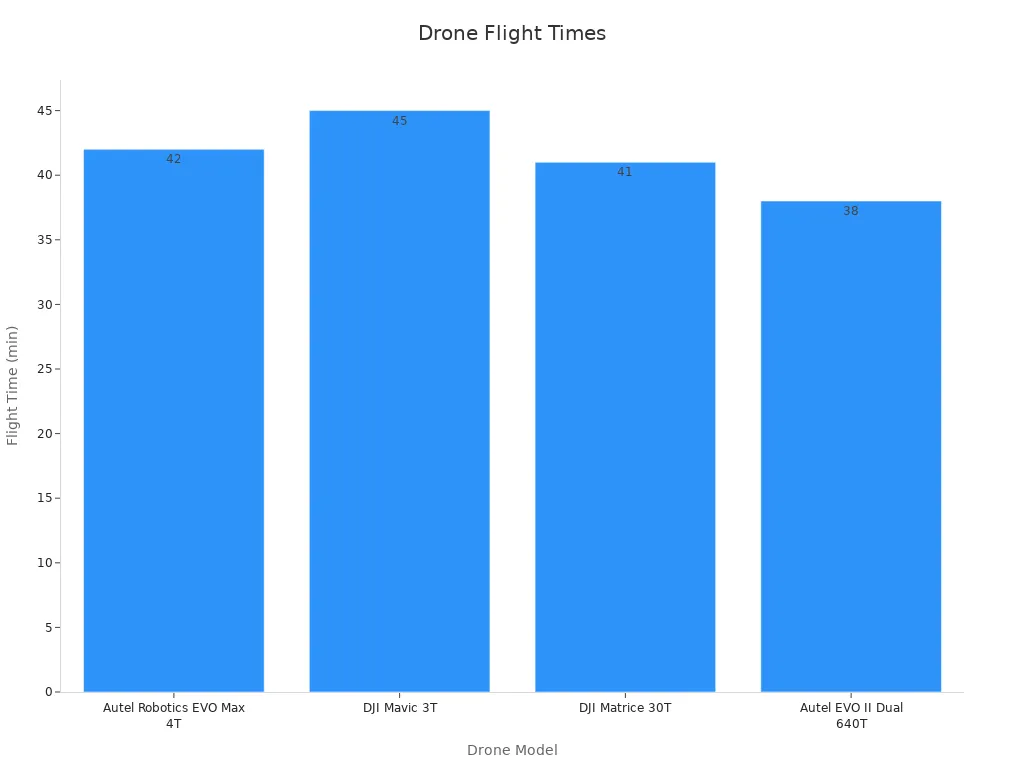
Parrot Anafi USA
The Parrot Anafi USA is light and follows NDAA rules. It uses a FLIR thermal camera and has a 32x zoom lens. You get up to 32 minutes of flight time. This drone is easy to carry and set up, so it is good for quick jobs.
The Anafi USA is helpful for tactical work, police, and checking the environment. Its encrypted links and GPS/GLONASS keep your data safe and correct. This model is a top choice for people who want secure, reliable night vision drones.
DJI Matrice 350 RTK
The DJI Matrice 350 RTK is strong and made for big jobs. It can use high-resolution thermal camera payloads and carry up to three sensors at once. It has smart obstacle navigation and RTK positioning for very accurate flying.
You should use the Matrice 350 RTK for industrial checks, mapping, and public safety. It is good for hard jobs where you need both thermal and visual data. This drone is one of the best thermal drones for people who want power and flexibility.
Skydio 2+
The Skydio 2+ is known for flying by itself. It uses smart AI and 720° obstacle avoidance to stay safe, even in small spaces. The thermal camera gives clear images for search and rescue or checks.
The Skydio 2+ is good if you want a drone that can fly on its own and avoid things. It is great for night vision drones work where GPS is weak. Many people trust it for quick use and good results.
Anzu Raptor Thermal
The Anzu Raptor Thermal is a new favorite in 2025. It has a high-resolution thermal camera and can connect from far away. You can fly for a long time and get real-time data, even in hard places.
The Raptor Thermal is useful for industrial checks, watching wildlife, and emergency response. Its multisensor suite has thermal, zoom, and wide cameras for many types of images. This drone is a smart pick if you want the newest tech in night vision drones.
Note: Many of the best thermal drones now use thermal cameras with RGB and LiDAR sensors. This gives you better data for checks, mapping, and search and rescue.
Thermal Camera Used in Drone Technology
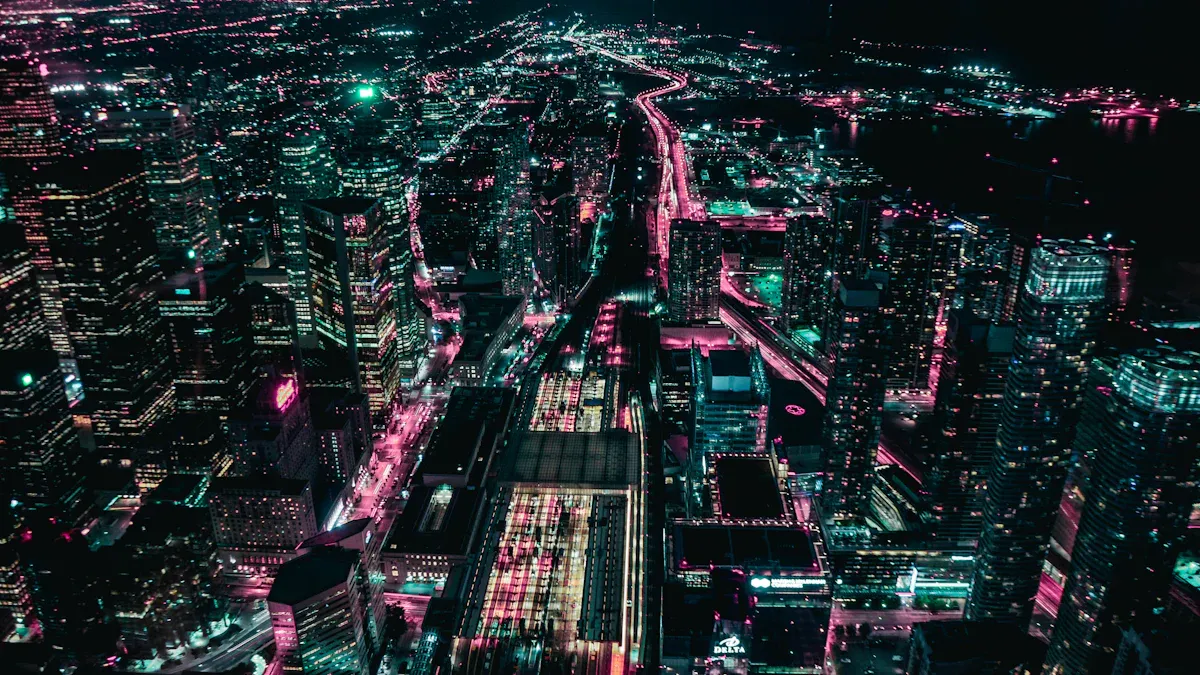
How Thermal Cameras Work
You may wonder how the thermal camera used in drone systems works. These cameras do not see light. They sense heat from everything around us. All objects give off heat, even if you cannot see it. The thermal camera used in drone technology takes this heat and makes a picture. This is called thermal imaging. Warm things look bright, and cool things look dark. The thermal camera used in drone flights can find heat from people, animals, or machines, even when it is very dark. Some drones have cooled sensors for more detail. Others have uncooled sensors that are lighter and cost less. The thermal camera used in drone missions works best when you fly at the right height and speed.
Aspect | Explanation |
|---|---|
How it works | Detects heat, not visible light |
Sensor types | Cooled (high detail), Uncooled (lighter, less detail) |
Best conditions | Works in darkness, smoke, or fog |
Key Benefits for Aerial Imaging
Thermal imaging helps you see things your eyes cannot. The thermal camera used in drone setups lets you find problems fast. You can spot hot spots on solar panels or see through smoke in fires. You can also find missing people in search and rescue. Thermal imaging keeps you safe because you do not need to go near danger. Drones with thermal imaging save money. You do not need a helicopter or a big team. New drones use AI to find trouble and guess where fires might go. The thermal camera used in drone inspections can see through thick trees or smoke. This makes it great for firefighting and search and rescue.
Tip: Thermal imaging drones can cover large areas fast and give real-time updates.
Typical Applications
You can use the thermal camera used in drone projects for many jobs. Here are some common uses:
Firefighting: Finding hot spots and people in smoke.
Search and rescue operations: Finding lost hikers or animals by their heat.
Checking solar panels for problems.
Inspecting power lines and buildings.
Watching wildlife at night with an infrared camera.
Checking industrial sites for safety.
Thermal imaging is changing how you handle emergencies and protect the environment. It also helps keep people safe. The thermal camera used in drone work gives you new ways to solve problems and see things differently.
Features of the Best Thermal Drones
Sensor Resolution
When you check out thermal drones in 2025, sensor resolution is very important. A high-resolution thermal camera helps you see small temperature changes. Most top models, like the DJI Mavic 3T and Autel EVO MAX 4T, have a 640×512 thermal sensor. This gives you clear thermal imaging, even from high up in the sky. You can find heat loss in buildings or look for people during search and rescue. Night vision drones with advanced thermal sensor tech show sharp images, even when it is totally dark. Makers now add low-light sensors to help drones work better in hard situations.
Flight Time
If your drone flies longer, you can check more places without stopping. Many of the best thermal drones can fly for 38 to 50 minutes on one battery. This happens because batteries and motors are better now. You can finish big inspections or search large areas without hurrying. Night vision drones with long flight times help you work safely at night or far away. Look at this chart to see how long each drone can fly:
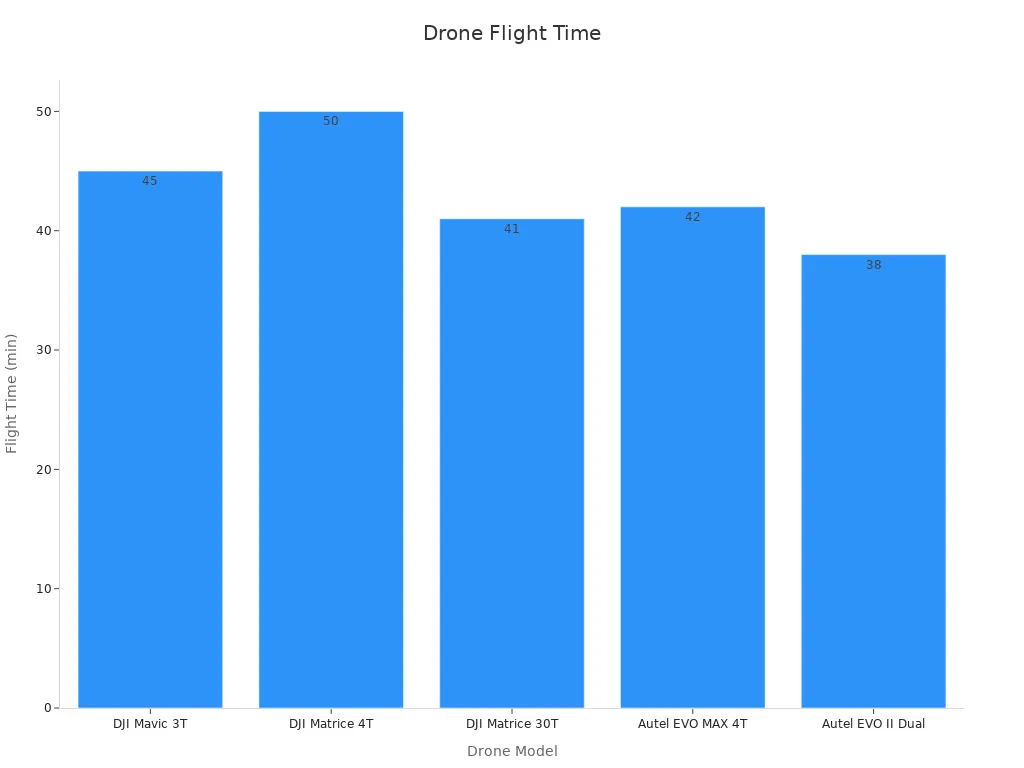
Imaging Software
Imaging software makes your work easier. The best thermal drones use AI tools for tracking, mapping, and real-time checks. You can find problems quickly with thermal imaging overlays and smart alerts. Some drones let you switch between thermal camera and normal video with one tap. Night vision drones now use low-light sensors and AI to avoid things, even in the dark. The software does the hard work, so you can do more with less effort.
Durability
You need a drone that can handle tough jobs. The best thermal drones have strong frames and can handle bad weather. You can fly in rain, dust, or wind without worry. Many night vision drones fold up for easy travel but stay strong when you use them. Makers test these drones in hard places to make sure they last. Low-light sensors and tough builds mean you can trust your drone on any job.
Tip: Always check the thermal camera specs and durability ratings before you buy. This helps you pick a drone that fits your needs and keeps working, even in rough conditions.
Drone Model | Sensor Resolution | Flight Time (minutes) | Imaging Software Features | Durability & Robustness |
|---|---|---|---|---|
DJI Mavic 3T | 640×512 Thermal Sensor | 45 | Advanced optical sensors, 56× hybrid zoom, omnidirectional obstacle avoidance | Portable, stable, designed for complex environments |
DJI Matrice 4T | 640×512 Thermal Sensor (New Gen) | 50 | AI target tracking, RTK, advanced AI processing, improved obstacle avoidance | IP55 weather-resistant, rugged design |
Autel EVO MAX 4T | 640×512 Thermal Imager | 42 | AI-powered mission modes, omnidirectional obstacle avoidance, SDK support | Foldable, anti-interference capabilities |
You can see that high-resolution thermal cameras, long flight times, smart imaging software, and strong builds make the best thermal drones in 2025. Night vision drones with advanced thermal sensor and low-light sensors help you work smarter and safer in every condition. The market keeps growing, and you get better tools every year.
How to Choose Thermal Drones
Professional vs. Hobbyist Needs
When you look at thermal drones, think about how you will use them. If you work in firefighting, agriculture, or public safety, you need a drone for professional jobs. These jobs need special sensors and software to collect and study data. You might use thermal drones to check solar panels or power lines. You can also use them to find people in emergencies. These drones help you finish work faster and keep you safe.
If you fly drones for fun, your needs are not the same. You want a drone that is simple and not too costly. Most hobbyists use thermal drones to take pictures or just explore. You do not need fancy thermal cameras or hard-to-use software. You just want to see cool images and maybe try some easy firefighting practice or look for animals.
Tip: Professionals should get drones with more features and better sensors. Hobbyists can choose basic models that cost less.
Budget and Value
How much money you have is important when picking a drone. Professional drones cost more because they have better cameras and software. If you want a budget-friendly industrial thermal drone, look for one with good features and a fair price. Some brands give you good value and still have quality. Hobbyists can find thermal drones that are cheap but still take nice pictures.
A budget-friendly industrial thermal drone helps small businesses or fire teams start using aerial imaging. You do not need to spend a lot to get good results if you pick the features you need most.
Application-Specific Advice
Think about what you want your drone to do before you buy. If you work in firefighting, pick a drone that finds hot spots and keeps your team safe. For search and rescue, choose drones with long flight times and strong thermal cameras. If you check buildings or power lines, get a model with high-resolution sensors and good mapping software.
Write down your top needs before shopping. This helps you pick the right thermal drones for your work. You get better results when your drone fits your job.
Regulations and Practical Tips for Thermal Drones in 2025
Legal and Certification Requirements
You need to follow important rules when you fly thermal drones in 2025. These rules keep you, your drone, and others safe. Here are some key requirements:
FAA Part 107 Remote Pilot Certification: You must have this if you fly drones for work in the U.S. It shows you know airspace, weather, and safety.
Drone Registration: If your drone weighs more than 0.55 pounds, you must register it. Put the registration number on your drone.
Airspace Authorization: Always check where you can fly. Use apps like B4UFLY or AirMap to see if you need special permission.
NDAA Compliance: Some jobs, like government work, need drones that do not use banned parts from certain countries.
Blue UAS and Green UAS Certification: Blue UAS is for high-security jobs and means your drone passed tough tests. Green UAS is for commercial work and checks for good cybersecurity.
Data Privacy Laws: If you collect data, follow rules like GDPR in Europe or CCPA in California. Keep your data safe and tell people how you use it.
Tip: Always do pre-flight and post-flight checks. Report any accidents right away.
Training and Support
You get better results when you know how to use your thermal drone. Many companies offer training classes. These classes teach you how to fly, use the camera, and follow the rules. Some brands give you online videos or manuals. You can also join drone groups to ask questions and share tips.
Practice flying in open spaces first.
Learn how to read thermal images.
Stay updated with new rules and software.
Note: Good support from the maker helps you fix problems fast.
Maintenance
Taking care of your drone keeps it working longer. You should:
Check the propellers and battery before each flight.
Clean the camera lens gently.
Update the software when you see new versions.
Store your drone in a dry, safe place.
Task | How Often | Why It Matters |
|---|---|---|
Battery check | Every flight | Prevents crashes |
Lens cleaning | Weekly | Keeps images clear |
Software update | Monthly | Adds new features, fixes bugs |
Full inspection | Every 3 months | Finds wear and tear early |
If you follow these tips, your thermal drone will stay safe, legal, and ready for any job.
You have seen the top thermal camera drones for 2025, each with unique strengths for different jobs. Choosing the right drone means thinking about your needs, budget, and local rules. Industry research shows that matching your drone to your work and following new regulations helps you get the best results. 📈 Before you buy, talk to vendors or try a demo. Stay updated by joining drone forums or following industry news. Your perfect drone is out there—make sure it fits you.
FAQ
What is the main use of a thermal camera drone?
You can use a thermal camera drone to find heat. It helps you spot people, animals, or hot spots in fires. Many people use these drones for search and rescue, inspections, and safety checks.
How far can a thermal drone see at night?
Most thermal drones can spot heat from people or animals up to 300–500 feet away at night. The exact range depends on the camera’s resolution and the weather.
Do I need a license to fly a thermal drone?
Yes, you need a license if you fly for work in the U.S. The FAA Part 107 certificate is required. If you fly just for fun, you do not need this license, but you must still follow safety rules.
Can I use a thermal drone in the rain?
Some thermal drones, like the DJI Matrice series, can fly in light rain. Always check your drone’s weather rating before flying. Most hobby drones are not waterproof.
See Also
Top Thermal Imaging Cameras For Drone Use In 2024
How Thermal Imaging Cameras Are Changing Drones In 2024
Key Advantages Of Using Thermal Cameras On Drones In 2024
Benefits Of Thermal Imaging For Drone Aerial Footage In 2024
Contact Us: Ms. Coco Huang
E-mail: sales@iasun.cn
WhatsApp/Wechat: +86 13510421923

